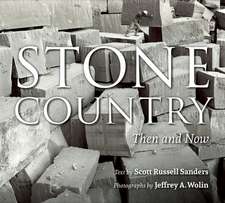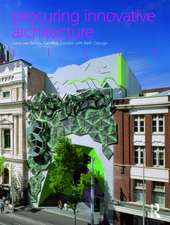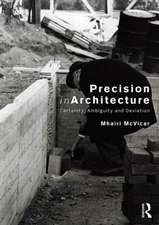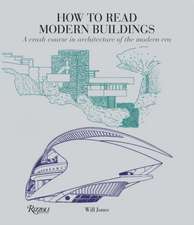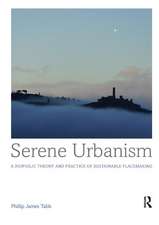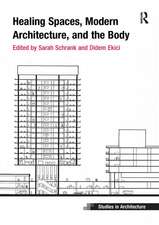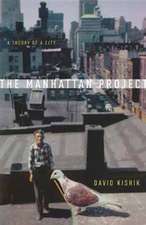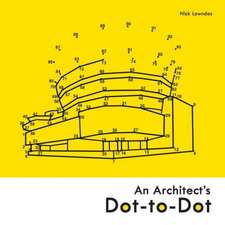Cinematic Aided Design: An Everyday Life Approach to Architecture
Autor François Penzen Limba Engleză Paperback – 25 aug 2017
The everyday life is one of the hardest things to uncover since by its very nature it remains overlooked and ignored. However, cinema has over the last 120 years represented, interpreted and portrayed hundreds of thousands of everyday life situations taking place in a wide range of dwellings, streets and cities. Film constitutes the most comprehensive lived in building data in existence. Cinema created a comprehensive encyclopedia of architectural spaces and building elements. It has exposed large fragments of our everyday life and everyday environment that this book is aiming to reveal and restitute.
| Toate formatele și edițiile | Preț | Express |
|---|---|---|
| Paperback (1) | 396.06 lei 3-5 săpt. | +28.77 lei 5-11 zile |
| Taylor & Francis – 25 aug 2017 | 396.06 lei 3-5 săpt. | +28.77 lei 5-11 zile |
| Hardback (1) | 769.92 lei 6-8 săpt. | |
| Taylor & Francis – 25 aug 2017 | 769.92 lei 6-8 săpt. |
Preț: 396.06 lei
Nou
Puncte Express: 594
Preț estimativ în valută:
75.80€ • 78.84$ • 62.57£
75.80€ • 78.84$ • 62.57£
Carte disponibilă
Livrare economică 24 martie-07 aprilie
Livrare express 08-14 martie pentru 38.76 lei
Preluare comenzi: 021 569.72.76
Specificații
ISBN-13: 9780415639088
ISBN-10: 0415639085
Pagini: 262
Ilustrații: 182
Dimensiuni: 189 x 246 x 20 mm
Greutate: 0.61 kg
Ediția:1
Editura: Taylor & Francis
Colecția Routledge
Locul publicării:Oxford, United Kingdom
ISBN-10: 0415639085
Pagini: 262
Ilustrații: 182
Dimensiuni: 189 x 246 x 20 mm
Greutate: 0.61 kg
Ediția:1
Editura: Taylor & Francis
Colecția Routledge
Locul publicării:Oxford, United Kingdom
Public țintă
Postgraduate, Professional, and UndergraduateCuprins
Introduction 1. The Case for Everydayness Part 1: Everydayness and Cinema 2. Introduction to Everydayness and Cinema 3. The Value of Fiction and the Role of Disruptions 4. Georges Perec & Chantal Akerman 5. Rhythmanalysis 6. Cinematic Typologies of the Everyday Part 2: An Architectonic of Cinema 7. Introduction 8. Windows 9. Doors 10. Stairs 11. Joining the Dots Part 3: Cinematic Aided Design 12. Towards a Cinematic Approach to Everyday Life and Architecture
Notă biografică
Professor François Penz is the Head of the Department of Architecture at the University of Cambridge, a former Director of The Martin Centre for Architectural and Urban Studies and a Fellow of Darwin College. He directs the Digital Studio for Research in Design, Visualization and Communication. His current AHRC research project, ‘A cinematic musée imaginaire of spatial cultural differences’ (2017-2020), expands many of the ideas developed in this book to other cultures (China and Japan in particular), construing films of everyday life as a revelator of deep spatial cultural differences.
Recenzii
'In Cinematic Aided Design François Penz has invented a kind of meta architecture, an imaginary Cinecitta where the production of architecture and film reflect and refract each other’s gaze on the everyday. Penz casts Henri Lefebvre and Georges Perec to lead a purposely in-disciplined ensemble cast of film makers and architects to find our truths in the everyday space of our lives.' - Tom Emerson, director, 6a architects, London & professor at the Department of Architecture, ETH Zürich, Switzerland
'In Cinematic Aided Design, François Penz argues persuasively that narrative cinema offers a vast library of demonstrations of architecture in use. Exploring the everyday spaces of fiction films, he identifies the essential value of moving images for architects and architecture.' - Patrick Keiller
‘Francois Penz is interested in what happens to architecture once it is handed over to a client, and he sees film as an accidental archive that makes visible how we live, love, work and sleep in buildings. His fascinating book offers some sparkling insights into how architects can enrich the design process with mundane knowledge. More than that, it is the best account I have read of how cinema can help us to understand the everyday.’ - Joe Moran, Professor of English and Cultural History, Liverpool John Moores University, UK
'In Cinematic Aided Design, François Penz argues persuasively that narrative cinema offers a vast library of demonstrations of architecture in use. Exploring the everyday spaces of fiction films, he identifies the essential value of moving images for architects and architecture.' - Patrick Keiller
‘Francois Penz is interested in what happens to architecture once it is handed over to a client, and he sees film as an accidental archive that makes visible how we live, love, work and sleep in buildings. His fascinating book offers some sparkling insights into how architects can enrich the design process with mundane knowledge. More than that, it is the best account I have read of how cinema can help us to understand the everyday.’ - Joe Moran, Professor of English and Cultural History, Liverpool John Moores University, UK
Descriere
Written by a world-renowned expert in the field, here he pioneers novel modes of investigations in the belief that the moving image provides us with new perceptual equipment to grasp the complexity of architectural and urban phenomena.

